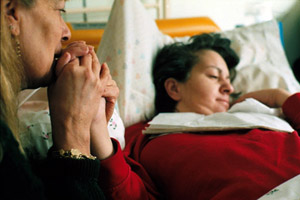
|
||
L'ultimo anno di sofferenze di Briton Donna Mellowship, colpita da encefalopatia infettiva nel gennaio 1996.Ci siamo permessi di
dare rilievo a questa documentazione affinchè ci si possa rendere conto degli effetti
sulla salute umana derivanti dalla pura speculazione di un sistema di produzione
scriteriato.
|

Clicca sulla foto per andare al
documento completo
|
The first sign that something was
wrong with Briton Donna Mellowship came in Jan. 1996. "She was quiet—but then Donna
was always quiet," her mother Pat says. Alarm bells really rang the day Donna forgot
to give her two kids breakfast. Always the model mother, she had never done such a thing. Donna declined rapidly. She lost her memory. Her hands shook so violently that she couldn't hold a cup of tea. She would just sit and shuffle her feet. But what was the problem? A hospital visit yielded a diagnosis of acute depression. One doctor said, "You know this is all self-inflicted. She just wants attention." Not until late June did anyone even suggest that the problem could be neurological. After a series of tests—a spinal tap, a CAT scan, two EEGs and a brain biopsy—neurologist Jeffrey Gawler finally identified Donna's condition as a case of Creutzfeldt-Jakob disease, or CJD. The diagnosis resolved the troubling uncertainty that had plagued the family. But it prompted another, larger question: what do we do now? In fact, they didn't have much time to think. As Pat says, "We had a kind of crash course in nursing. You've got to learn how to use a feeding machine, a suction machine, oxygen, giving medication. And then there's changing and dressing her—stuff you do when they're babies, but when someone's an adult, it's a lot harder." Particularly true given Donna's state and the rapid deterioration of the typical CJD victim. Those stricken are expected to die within a year. Under her family's care, Donna lasted almost two—until Dec. 31, 1997. "She had all the best care, all the love we could give," Pat says. "And she wasn't in hospital but at home, where she wanted to be." Photographer Greg Williams was there, too, spending months with the Mellowships, documenting and observing the effects of CJD on both Donna and her family. What follows is a selection of his photographs from Donna Mellowship's last year of life. |